Planning for hazardous areas in a distillery
I once listened to a speaker talking about safe design of a distillery and he emphasised the fact that designing from scratch was so much cheaper than retrofitting an existing space. There is no doubt that this is true but in Australia most distilleries have been established already and the oportunity to design from scratch has long passed. I think I am correct in saying that most distilleries are not fully compliant with hazardous area codes and understanding them, and the options, will go a long way to planning now for the most economical way to achieve compliance. I have already written an introduction to hazardous areas in a distillery and this article follows up with a few specific options to think about.
(Note: the calculations are specific in nature and do not cover any other layouts and scararios)
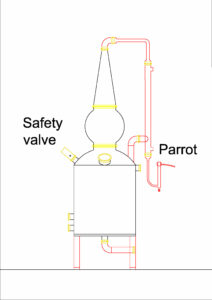
Figure 1 – Pot Still
You could take a short cut and get a consultant to assess your distillery as, say, Zone 1 in which case you will need every piece of electrical equipment to be certified Ex db IIB T2 Gb, which is one of the highest ratings for explosion proof equipment, though not the highest. So your heating elements, light fittings, switches, junction boxes, ventilation fans, temperature probes, detectors, etc, would need to have this certification. I am going to look a couple of scenarios to see how a zone is analysed, and what the result of this analysis is.
Let’s look at a standard pot still (see Figure 1) in a room and consider the safety valve and the parrot and the risks inherent with these parts. A safety valve is supposed to release vapour when there is an over-pressure event. It is not something that happens during normal operation and it is, in fact, rare in distilling. But is can happen. According to AS60079.10.1 the zone around the valve would be classified as Zone 2. Let us assume that the still is, say, 200L capacity and the distillation is running with a power supply of 5.5kW. Let us also assume that there is nominal natural ventilation in a room that is L9 xW6 x H3.5. There are a bunch of calculations from which we can determine that the concentration of alcohol in the room will reach 9% ABV and this is well above the safe limit of 0.775% ABV. The safe limit is 25% of the lower flamability limit (LFL) of alcohol which is 3.1%. One of the calculations is the release rate of alcohol and it is related to the power input (less heat losses from the still). After stopping the release it would take 5 hours for the room to geet to a safe level again and as a result the zone classification would be revised to Zone 1 and require all the equipment to be explosion proof.
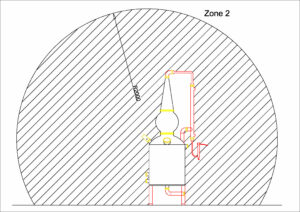
Figure 2 – extent of Zone 2 with artificial ventilation
Let us change the assumption to an artificially ventilated room, meaning that there is a fan sucking air from the room and blowing it outside at a rate of 1500m3/hr, which means replacing the air in the room 8 times every hour. The “background concentration” in the room would level out at 0.68% ABV which is slightly less less than the safe level of 0.775%. The extent of the zone is established by using Figure D1 and a radius of 2m applies (see Figure 2).
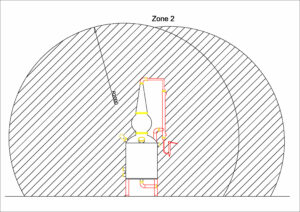
Figure 3 – SV & Parrot zone extent
We can do the same exercise for the parrot. A risk that is not commonly assessed is the case where water to the condenser runs out and all the vapour in the still blows out the parrot. Most parrots have vents and this is where the vapour would blow out. The release rate is exactly the same as the case for the safety valve and the superimposed extent of the zones is shown in Figure 3.
Any electrical equipment in the area shede Zone 2 would require explosion proof certification and the fan would have to be explosion proof too. At least we have reduced Zone 2 from the whole room to only the shaded area.
There is a point where we can get the Zone 2 area to be non hazardous and it is when the “background concentration” (Xb) is much less than the safe level (Xcrit). What does ‘much less’ mean? I am not certain because 60079-10-1 does not specify, but let’s say it is less than by a factor of about 10. There is a ventilation rate that will achieve this and by my calculations it is about 13,000m3/hr, or 70 room changes per hour in our considered case.
The safety valve (SV) doesn’t have to vent into the room, there is nothing stopping a few plumbing pieces from moving the SV outside the room and venting, say, from above the roof. The same goes for the parrot; with a parrot designed differently it could also be plumbed to the outside (see Figure 4 for the parrot design).

Figure 4 – Parrot with venting facilities
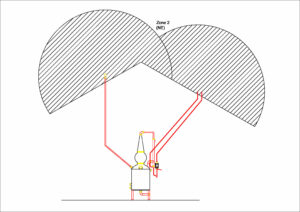
Figure 5 – Venting to the outside
If the vents are outside the Zone 2 area will be outside, and when taking account of Table C1 and Figure C1 in AS60079.10.1 we see that the zones are considered of negligible extent (NE) – a much safer scheme.
Does this mean that the room is now in the clear? The answer is no; there are still a number of scenarios to consider and each one needs to have the calculations performed to get to the result. I want to consider spills, particularly from the boiler as it can happen just by kicking a vlave by mistake. Most distilers already understand the need to have bunding to contain a spill and the reason is pretty obvious – to contain the hazardous liquid so the area it affects is limited.
In our considered case we have 200L boiler and assume the bund is 30mm high so the bunded area would be almost 7m2. There are a bunch of calculations to estimate the release rate of alcohol vapour from a ‘pool’ and they take account of the ABV of the liquid, its temperature, vapour pressure, velocity fo air flowing over it, ambient temperature and area (7m2 in our case). The calculations have a feature that fights with our instincts – if we want to dilute the alcohol to safe level, we need to increase the ventilation rate. But, the higher the ventilation rate, the higher the release rate from the pool.
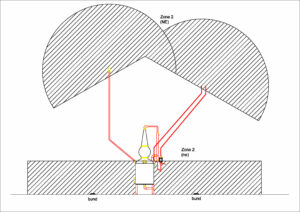
Figure 6 – zone around bunded area
Let us assume that the boiler is filled with 50% ABV alcohol and spills at ambient temperature, so air is 25C and liquid is 25C, and that the ventilation rate is 500m3/hr. The calculations show that Xb is much less than Xcrit and the zone classification will be non hazardous. As the temperature of the liquid goes up the ventilation required is higher, so lets consider our 50% ABV liquid has just started to boil at about 83C and the fan is running at 500m3/hr. The calculations show that Xb is now 0.3*Xcrit which is pretty low and may be considered “much less than”. If we increase the ventialtion by 10 times to 5000m3/hr the calculations show that Xb = 0.2*Xcrit. Not much improvement in Xb for such a big increase in ventilation. It is for this reason that it is most likely that when Xb = 0.2*Xcrit the zone would be classified as non hazardous and in this case it is with ventilation of 3500m3/hr. The zone drawing would look like Figure 6, extending 2m past the bund and 1m above it.
What this assessment means is that the electrical equipment in the space could be normal, except for the safety equipment which would have to suited to Zone 2 (Ex dc IIB T4 Gc). Safety equipment would include the fan, level switch to the boiler, and detectors and any temperature probes performing a safety function.
What is important to note here is that, for the considered case, plumbing vents outside will have a huge impact on reducing the cost of electrical equipment and it is relatively easy to do. The size of a fan and associated ducting is greatly reduced when only the bunded area needs to be taken into account for ventilation.

